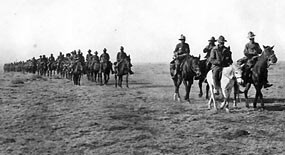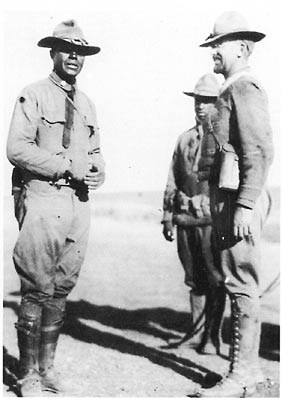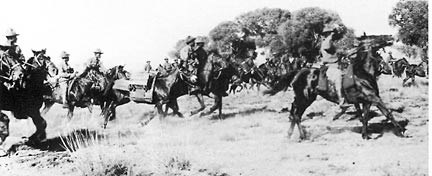
In 1915, the political situation throughout Mexico and along its border with the United States had grown explosive. The U.S. Army patrolled the border from the mouth of the Rio Grande in Texas to San Diego, California, a distance of 1700 miles. On March 9, 1916, Mexican revolutionary Pancho Villa attacked sleeping citizens and soldiers in the town of Columbus, New Mexico, ending a period of watchful waiting. President Woodrow Wilson ordered Brigadier General John J. Pershing, to lead a "Punitive Expedition" of U.S. troops into Mexico in pursuit of Villa and his band. Among the troops crossing into Mexico were the 10th Cavalry Buffalo Soldiers commanded by Colonel William Brown. The senior Major in the Regiment was Major Charles Young. 
The Mexican Punitive Expedition was the last time that horse-mounted troops would play a significant role in an American military operation. The army was already replacing their old reliable steeds and mules with trucks and automobiles. The troops were often in the saddle for over seventeen hours a day, riding through rough, irregular terrain in pursuit of Villa. The 10th Cavalry took part in several tactical actions. Near Aguas Calientes, Major Young, now a Squadron Commander, led his troops in an attack on about 150 Villistas, who retreated with the Buffalo Soldiers in pursuit. At El Mesteno, the opposing forces could not be dislodged by rifle fire. Colonel Brown ordered Major Young to mount up and charge the enemy flank. Young's men dropped back from the firing line, ran to their horses, and mounted up to form a line with pistols drawn. At Major Young's signal, they moved forward at a gallop, threatening to envelop the Villistas' right flank. The troopers didn't fire a shot, but they did start moving faster and yelling. The Villistas refused to meet the charge, ceased firing, and disappeared into the woods. (35) A month later at Hacienda Santa Cruz, Major Young led his squadron to the relief of 13th Cavalry troops, who were in danger of being wiped out. Young's reinforcement prevented a disastrous defeat for these American troops. 
Another action involving the 10th Cavalry was not successful. In June of 1916, C Troop and K Troop ran into a trap set by Mexican Federal soldiers near the town of Carrizal. Outnumbered, two officers and ten enlisted men were killed. Twenty-three troopers were taken prisoner. Fighting back, the Buffalo Soldiers killed forty-five of the Federal soldiers including their commander. (36) In due time the captives were returned to the American command. (37) By the end of the Punitive Expedition, the 10th Cavalry and three other regiments had penetrated nearly 500 miles into Mexico. (38) Charles Young was promoted to the rank of Lieutenant Colonel in the 10th Cavalry in July of 1916, the second-most senior position in the regiment, and the first time an African American would reach that grade as a "line officer" in the regular army. Six months later, President Wilson, who had campaigned for reelection with the slogan, "He kept us out of war," ended the Punitive Expedition and ordered the troops to return to the United States to begin preparations for the war in Europe. < Return to Buffalo Soldiers Home |
Last updated: February 9, 2022
